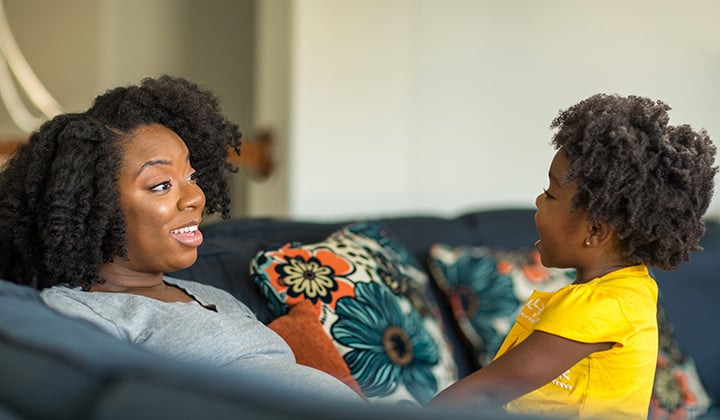
Concerned about your child meeting language milestones? You’re not alone. I often work with children whose parents are really concerned their children are not yet talking. One thing I try and point out is there are often ranges for children in regards to speech-language milestones. Here’s what I mean.
A lot counts
Parents often don’t realize communication can mean more than verbal words. Sounds, what the child understands, and gestures or sign language count as “words” when we’re considering early communication milestones.
A child may communicate by pointing or gesturing for what they want, even if they aren’t yet saying a true word. This child is using non-verbal communication to meet their want and needs. Over time, the goal is these non-verbal means of communication will turn into verbal means of communication. We encourage parents to pair words with these gestures or signs they see their child doing. For example, if a child is pointing to a cookie they want, we encourage parents to acknowledge this behavior and state “you are pointing to a cookie”. “Do you want a cookie to eat?” This child then hears the word cookie and is also acknowledged for their communication attempt (i.e. pointing).
We also encourage parents to expand a child’s vocabulary through reading books and simply talking to them about daily events or activities. A child’s comprehension is also looked at and a part of communication. This includes following simple directions and understanding what simple words mean. The more a child hears a word the more familiar with that item or object it references, they will become.
Milestones by age
Every child develops at their own pace. Medical conditions and babies born prematurely will need adjusted milestones, but here are a few common milestones to use as a guide from the American Speech-Language-Hearing Association.
0 to 6 months – Should be able to recognize your voice, smiles, giggles, makes cooing sounds, babbles with sounds like “pa”, “ba” and “ma”.
7 months to 1 year – Can respond with sounds when you talk. Says around 1-2 words like dada, mama, uh-oh. Will babble with longer sounds like papapa, bababa and mimimi.
1 year to 2 years – Able to say around 50 words. A child may also have a non-verbal vocabulary of sign language. Points to pictures, body parts or things when you ask. Says 2-word phrases like, “more milk “car go”, etc.
2 years to 3 years – Will understand or say at least 200 words. Asks the question “Why?” and can put 3 words together when talking. There is a big jump in this age group for the number of words in a child’s vocabulary. By the age of 3, it can be as large as 1,000 words.
3 years to 4 years - Uses lots of words including pronouns like I, we and me. Uses 4 words together when talking.
Ways to help your child communicate
Caregivers can play the biggest role in a child’s life when it comes to communicating. Children are soaking up everything you do. Here are a few tips to help children hear more words and learn to communicate.
- Praise their communication. Try to notice any signs of communication like gestures or sounds. For example, if they are reaching for the refrigerator, could mean they are hungry, or pointing out a window means they want you to look, too. Gestures and sounds all are parts of communication.
- Talk to your child. Every day there is tons of opportunity to talk about your daily routine, meals, getting dressed and describing your life out loud. “Here is your blue shirt. It goes over your head and we put your arms through the sleeves. Look, now you are wearing your blue shirt.”
- Add words. If your child says “more” you can respond with “More apple. Here’s more apple.”
- Read to your child every day. Books are a great way to share words and pictures and to expand a child’s vocabulary. Try not only to read the words in the book but also to describe the pictures. This can offer many chances to talk about new things. “Look at the cat. He has a tail. Do you see the cat’s tail?”
- Try new things. You don’t always need the most expensive toy or newest thing to play with your child, rather trying new experiences or playing with toys in a new way is another chance to offer new words. Going on a walk will create new experiences to share new words or ideas with your child. If your child already is playing with a ball it can be turned into a new experience by talking and expanding about how it’s used in different ways. “Is this ball red? No, it’s blue. We can roll the ball. We can hold the ball. We can hide the ball.” We can pretend the stuffed animal is kicking the ball.
During COVID-19, some parents may be concerned because kids are staying home more and hearing less communication than they normally would. I recommend getting siblings involved and trying video calls with friends and relatives. We may have to get a bit creative, but more exposure to language, in any form, will be good.
When to get help
Milestones are not a hard and fast rule, they are a guide. You know your child best, and if you feel their speech isn’t expanding or improving and are concerned, you can get your child evaluated by a speech-language pathologist. Depending on insurance, you may need a physician’s referral first. Early intervention is key, so if you aren’t seeing improvements in 3 to 4 months, trust your gut and bring them in.
Milestones are important, but they aren’t everything. Even by reading this article, you are already showing how invested you are in helping your child succeed.

